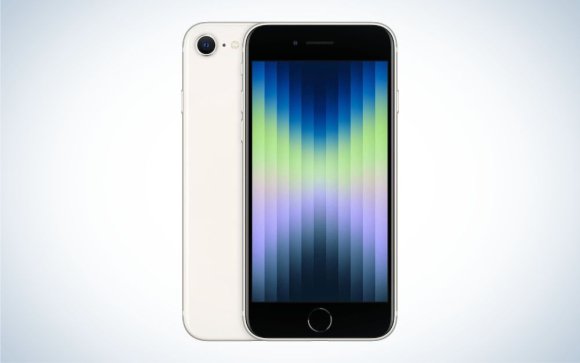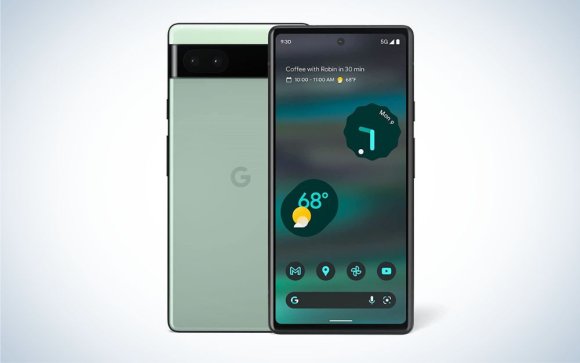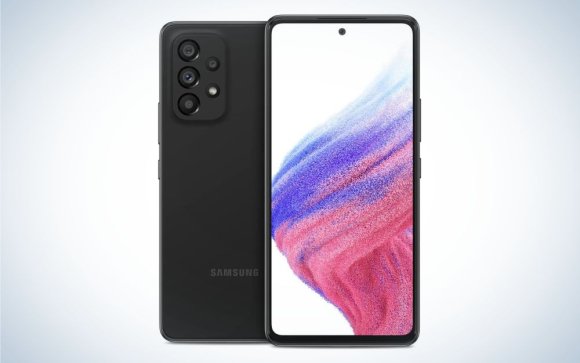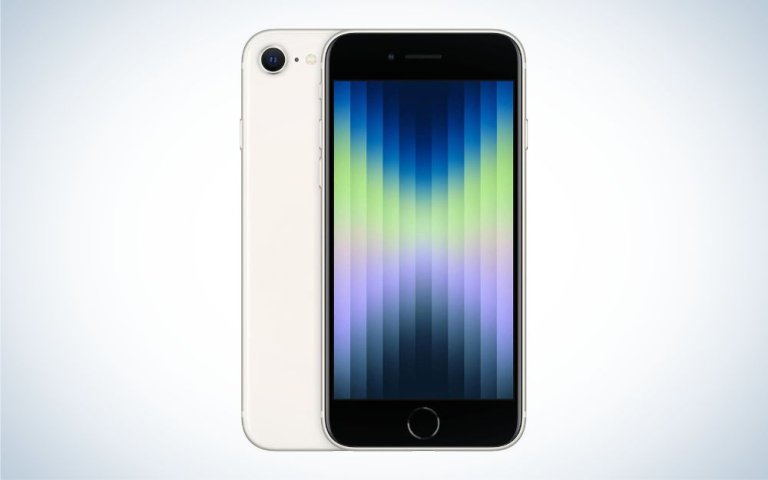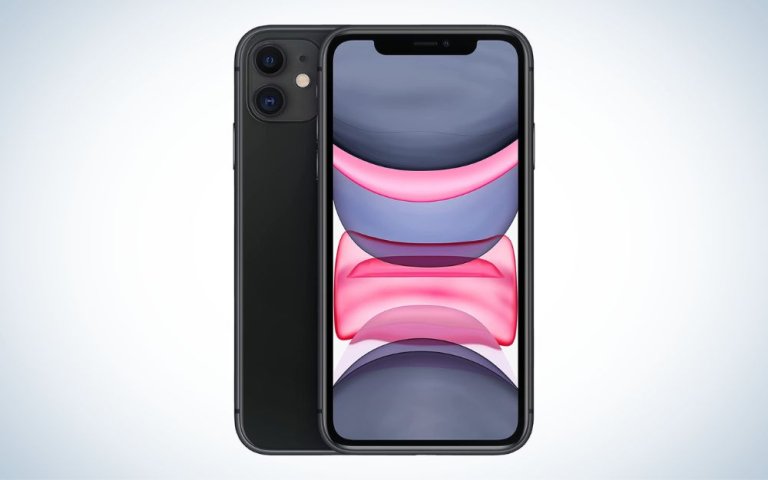We may earn revenue from the products available on this page and participate in affiliate programs. Learn more ›
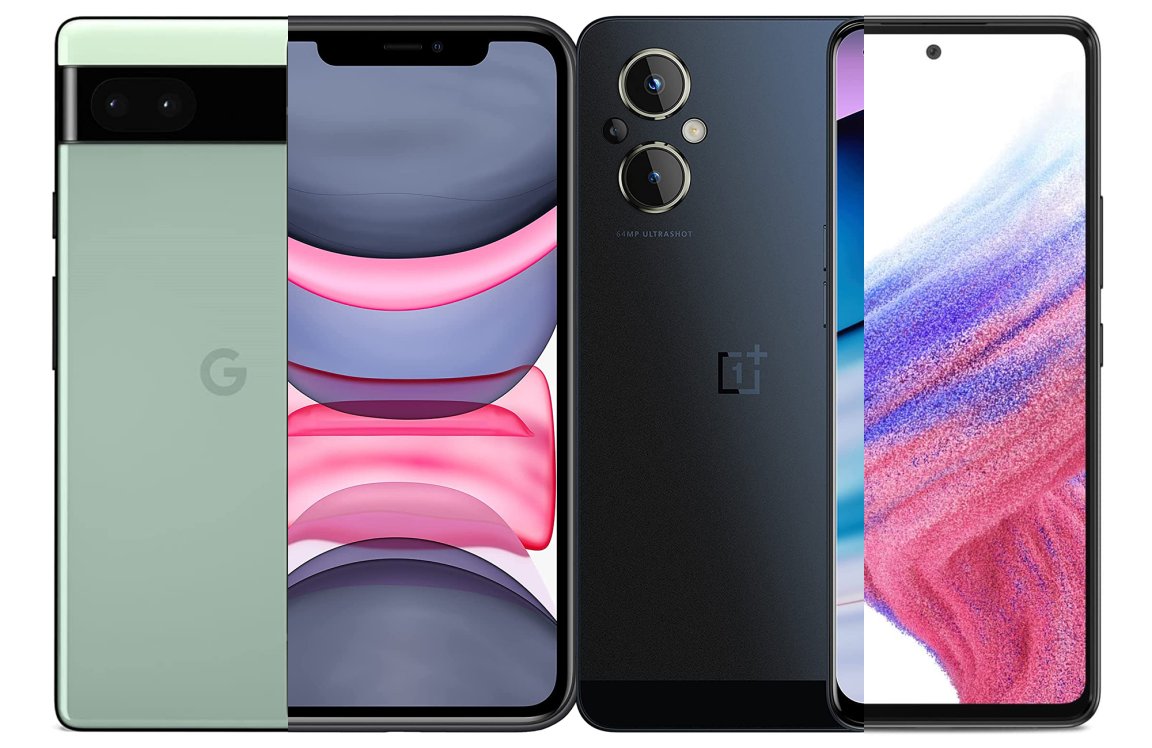
While $1,000 flagship phones are fun to geek out over, there are currently several excellent phones under $500 worth checking out. These devices are excellent for first-time buyers or anyone who wants to play games, make video calls, and download apps without spending tons of cash. Importantly, they offer years of software support, so you’ll get the latest features and security enhancements, which can extend the life of your device. You may miss out on some of the latest cutting-edge advancements found in premium models, like wireless charging and high refresh rate displays, but the best phones under $500 can often compete with alternatives that cost hundreds of dollars more.
- Best overall: iPhone SE (3rd Generation)
- Best camera: Google Pixel 6a
- Best display: Samsung Galaxy A53 5G
- Best gaming: iPhone 11
- Best budget: OnePlus Nord N20 5G
How we picked the best phones under $500
I’ve written about technology for over a decade for sites like TechnoBuffalo, XDA Developers, and Popular Science. During that time, I’ve reviewed dozens of smartphones, from the Nexus 6P to the recently introduced OnePlus 10 Pro. To select our picks, I drew on my experience writing about smartphones, consulted trusted sources and professional reviewers, and researched the most popular models available. As phones have become more affordable, I’ve begun to prefer mid-range options because they meet my needs and are often hundreds of dollars cheaper than flagship models.
Things to look for in the best phones under $500
The fact is that you don’t need to spend over $1,000 to get a good smartphone because affordable smartphones are better than ever and often offer a similar experience to premium models. As our list highlights, several good mid-range options offer excellent performance, long-lasting battery life, and impressive designs. If you’re searching for the most powerful flagships, you should check out our picks for the best Android phones available. Otherwise, here’s what to look out for when choosing the best phone under $500.
Performance
Like in a computer, your phone’s central processing unit, or CPU, is a critical component necessary to run applications and perform various tasks, from browsing the web to making video calls. Phones at this price generally offer a mix of high and mid-range specs. It’s not difficult to find an affordable device with a flagship processor that’s only a few months old, while other phones might feature a processor specifically for mid-range devices.
For example, Google has put its custom Tensor chip, which enables powerful AI-driven features, in the Pixel 6 and Pixel 6a. The former was released last October and the latter became available in July this year. Generally, Qualcomm and MediaTek make mid-range processors, but some companies produce custom-made silicon for their devices, including Google, Apple, and Samsung.
The amount of random access memory, or RAM, is also key to your device’s performance and provides applications with a place to temporarily store data and quickly access it again. Phones at this price typically have 6GB of RAM, give or take, which is enough to comfortably move between different tasks, including messaging, browsing social media, and watching videos.
Display
You’ll spend lots of time staring at your phone’s display, so this is one area in which you don’t want to skimp. Most phones available today, regardless of price, feature screens between 5 inches and 6 inches but the resolution and pixel density will vary. Typically, more affordable devices feature lower resolution—Full HD (1080p) or HD (720p)—liquid crystal displays (LCD). Some options on our list feature OLED displays, a technology where a light-emitting diode (LED) independently backlights each pixel.
A higher pixel density, measured in pixels per inch (PPI), translates to a sharper image. The higher the PPI, the sharper the image and the more difficult it is to distinguish individual pixels at an average viewing distance (about arm’s length). Meanwhile, a phone’s display refresh rate, measured in Hertz (Hz), refers to how many times your display updates what’s on the screen each second. The higher the refresh rate, the smoother and more fluid the animations will look. Displays that support a refresh rate of 120Hz are generally reserved for flagship devices but there are some rare exceptions in the mid-range market. A screen that supports a refresh rate of 60Hz or 90Hz is more common in the $500 range.
Software support
Software support for mid-range devices has historically been abysmal. But, in recent years, companies have done much better to support these devices with new (and timely) software updates. These updates are essential to your device’s long-term performance because they introduce new features, software optimizations, and plug security holes. At the very least, you should look out for a device that offers two years of major software updates and three years of security updates. Often, a company will continue to provide security support even after ceasing software support.
Carrier support
If you’re buying a device unlocked, make sure it has support for all major U.S. carriers. Generally, you should be able to pop your carrier’s SIM card into your new phone and start receiving texts, phone calls, and data. Retailers typically state what major U.S. carriers a phone supports, so it should be clear before you make your purchase. If you subscribe to Verizon, make sure the device you buy works with the carrier or says it’s CDMA-capable. Unlocked devices generally work without issue on AT&T and T-Mobile, which are GSM carriers (and the standard for most carriers worldwide).
The best phones under $500: Reviews & Recommendations
It can be difficult to discern a phone’s quality based on specs alone, especially when many offer the same components. Our list of the best phones under $500 will help you parse the details and find the model that works best for you. Not everyone’s needs are the same, so we’ve broken it down into different criteria. Whether you’re looking for a device for gaming or taking high-quality photos, we’ve got you covered.
Best overall: iPhone SE (3rd Generation)
Best overall
High Performer
See ItPros
- Powerful processor
- Wireless charging
- Excellent camera
Cons
- Outdated design
Specs
- Display: 4.7-inch, 1334 x 750, LCD, 60Hz, 326 ppi
- Processor: A15 Bionic
- RAM: 4GB
- Storage: 64GB
- Battery: 2018mAh
- Camera: 12MP f/1.8, OIS
- Software: iOS 15; planned upgrade to iOS 16
- Support: Apple generally provides four years or more of major OS and security updates
- 5G: Yes, sub-6GHz
Buy it used or refurbished: eBay
Why it made the cut: The iPhone SE offers flagship performance for a fraction of the price.
Although it features a legacy design and a smaller 4.7-inch display, Apple’s iPhone SE offers the best balance of performance, features, and software support. Notably, it comes equipped with the same A15 processor as Apple’s latest iPhone 13 and 13 Pro, which feature custom silicon with a 6-core CPU and 4-core GPU. The device also includes wireless charging, Touch ID, and IP67 waterproofing.
The iPhone SE offers all-day battery life and a 12MP wide camera with optical image stabilization and support for portrait mode and 4K video recording. Apple generally provides several years (five years or more) of major iOS updates to its devices, so even though the iPhone SE’s design looks old, its software will keep it feeling fresh. Plus, if you’re still clinging to the Touch ID home button instead of Face ID, this is your only hope.
Best camera: Google Pixel 6A
Best camera
Picture Perfect
See ItPros
- Fantastic display
- Excellent software support
- Flagship-level camera
Cons
- Slower fingerprint sensor
Specs
- Display: 6.1-inch, 1080 x 2400, OLED, 60Hz, 429 ppi
- Processor: Google Tensor Titan M2
- RAM: 6GB
- Storage: 128GB
- Battery: 4410mAh
- Camera: 12MP f/1.7, OIS; 12MP f/2.2
- Software: Android 12
- Support: Five years of security updates. Google hasn’t said how many OS updates it will receive, but the Pixel 6 has been promised three.
- 5G: Yes, sub-6GHz
Buy it used or refurbished: eBay
Why it made the cut: With Google’s Tensor chip, the Pixel 6A offers a camera that operates at a flagship level.
Google has earned a reputation for offering excellent mobile cameras, and the Pixel 6A is no exception. The device features a dual camera setup: a 12MP main camera carried over from the Pixel 5A and a 12MP ultra-wide camera borrowed from the Pixel 6. This setup benefits greatly from the Pixel 6A’s Tensor chip, a custom piece of silicon designed by Google. The processor enables advanced AI and machine learning features like Face Unblur, providing users with better portrait images in low-light conditions. The Tensor chip also supports HDR during video recording at 4K/60 frames per second. The Pixel 6A’s camera setup doesn’t quite match last year’s Pixel 6 or 6 Pro but, for the price, it still offers plenty of Google magic.
Best display: Samsung Galaxy A53 5G
Best display
Screen Time
See ItPros
- Excellent battery life
- Beautiful display
- Powerful camera setup
Cons
- Software can get bogged down by bloatware
Specs
- Display: 6.5-inch, 1080 x 2400, Super AMOLED, 120Hz, 405 ppi
- Processor: Exynos 1280
- RAM: 4GB
- Storage: 128GB
- Battery: 5000mAh
- Camera: 64MP f/1.8, OIS; 12MP f/2.2; 5MP f/2.4 (macro); 5MP f/2.4 (depth)
- Software: Android 12
- Support: Four years of major OS updates and five years of security updates.
- 5G: Yes, sub-6GHz
Buy it used or refurbished: eBay
Why it made the cut: The Galaxy A53 5G’s 6.5 looks fantastic, particularly when watching videos and playing games.
Samsung’s Galaxy A53 5G feels like a device that should cost way more than it does. It features a triple camera setup headlined by a 64MP main camera, a powerful Exynos processor, and excellent battery life. But the main standout is its 6.5-inch 1080p OLED display, which provides rich contrast and vibrant colors. It also supports a refresh rate of 120Hz, so animations look smoother than they do on devices with lower refresh rates. The display looks fantastic when performing daily tasks but shines when playing bright, colorful content like videos and games.
Other features offered by the Galaxy A53 5G include IP67 dust and water resistance and an in-display fingerprint scanner. Samsung has also promised four years of Android OS version updates and five years of security updates, which means you’ll be admiring the device’s OLED display for a long time.
Best gaming: iPhone 11
Best gaming
Game Time
See ItPros
- Excellent battery life
- Great camera setup
- Powerful performance
Cons
- Device is a few years old
- 64GB of storage can fill up quick
Specs
- Display: 6.1-inch, 1792 x 828, LCD, 60Hz, 326 ppi
- Processor: A13 Bionic
- RAM: 4GB
- Storage: 64GB
- Battery: 3110mAh
- Camera: 12MP f/1.8, OIS; 12MP f/2.4
- Software: iOS 15; planned upgrade to iOS 16
- Support: Apple generally provides four years or more of software and security updates
- 5G: No
Buy it used or refurbished: eBay
Why it made the cut: The iPhone 11 features a powerful processor, excellent display, and long battery life, making it a great choice for mobile gaming.
The iPhone 11 may seem like an odd choice given its age—it came out in 2019—but its A13 Bionic processor, with its hex-core CPU and 4-core GPU, still holds up. Not only does it perform well for everyday tasks like browsing the web, editing photos, and making video calls, but it handles the most intensive mobile games with aplomb—and the 6.1-inch display is nice and big for media.
Whether you play Minecraft, PUBG Mobile, or Diablo Immortal, the iPhone 11 continues to keep up with demanding apps and processes years after its release. You also get wireless charging, IP68 dust and water resistance, and an excellent camera system. Apple is known for providing older devices with several years of software support, so despite the iPhone 11’s age, it should provide users with a few more years of important updates. The only major downside is that the standard iPhone 11 only has 64GB of storage, which could quickly fill up with games.
Best budget: OnePlus Nord N20 5G
Best budget
Budget 5G
See ItPros
- Affordable
- Fantastic display
- Excellent performance
Cons
- Limited software support
Specs
- Display: 6.43, 1080 x 2400, AMOLED, 60Hz, 409 ppi
- Processor: Snapdragon 695 5G
- RAM: 6GB
- Storage: 128GB, microSD expandable
- Battery: 4500mAh
- Camera: 64MP f/1.8; 2MP f/2.4 (macro); 2MP f/2.4 (depth)
- Software: Android 11
- Support: One major OS update and three years of security updates
- 5G: Yes, sub-6GHz
Buy it used or refurbished: eBay
Why it made the cut: The OnePlus Nord N20 5G features an excellent screen and great performance at an affordable price.
The OnePlus Nord N20 5G is a sub-$300 phone that punches above its weight. It features a 6.4-inch 1080p OLED display, a Qualcomm Snapdragon 695 processor, and 6GB of RAM, making it more than capable of handling a heavy workload. It also offers a fingerprint scanner under the display and a 64MP camera, which doesn’t produce the best pictures we’ve seen, but it’s great for a phone at this price. The Nord N20 5G also supports 33W fast charging so that it can be charged from 0 to 30 percent in just 20 minutes. While the device supports 5G, it doesn’t work on Verizon and is limited to 4G on AT&T. If you’re on T-Mobile, however, you should have no issues.
FAQs
A modern device that’s well cared for should last three to five years. As outlined above, some flagship and mid-range phones share the same specs, so they will likely offer a similar lifespan. However, because flagship phones generally offer more RAM than mid-range options, the former may experience a slower decline in performance over time. The performance gap may not be apparent initially, but it could become more noticeable after a few years: Apps may be slower to load, and you could run into issues with multitasking. These issues could prompt those who own a mid-range phone to upgrade earlier than someone who owns a flagship device.
Hardware aside, you’ll have to factor software support into the life of the phone. Once a manufacturer stops offering essential software updates for a device, it’s time to transition off of it, even if the phone still works.
Statistically, Android phones have the largest user base globally—and by a wide margin. A big part of that is due to the wider variety of Android options. Several companies—Samsung, Google, OnePlus, Xiaomi, and many others—offer Android devices that cover a range of prices. By comparison, Apple’s iPhone has a smaller market share.
The short answer is Android is more open and flexible, while iOS is restrictive and tightly controlled. But the two platforms are similar in many ways and generally offer access to the same apps and perform the same functions. Additionally, both have borrowed liberally from one another and, after more than 10 years of updates, aren’t nearly as different as they once were. The platform you choose ultimately comes down to your personal preference. If you’re having trouble deciding which platform is right for you, this explainer offers a more thorough breakdown.
Most modern flagship and mid-range devices feature support for 5G, so it’s more or less unavoidable at this point. There are pros and cons to owning a 5G device. The maximum download speeds can be blazing fast—up to 1GB per second—and 5G networks offer more bandwidth, so there can be less congestion in crowded areas. However, 5G coverage remains sparse around the U.S., and 5G radios can drain your device’s battery more rapidly.
If you get a device with 5G, you’ll also need to find an area with 5G coverage and have a data plan that supports the network. If you wind up purchasing a device that doesn’t support 5G, you don’t need to worry. For more information about 5G, you can check out our coverage.
Final thoughts on the best phones under $500
The progress of technology has allowed mid-range devices to close the gap on more expensive flagship models, making it easier to get a good smartphone without spending a fortune. You may miss out on features like higher refresh rates and more advanced cameras. Still, you will find one of the best phones under $500 has excellent performance, features, and software support—and that’s money well spent.
